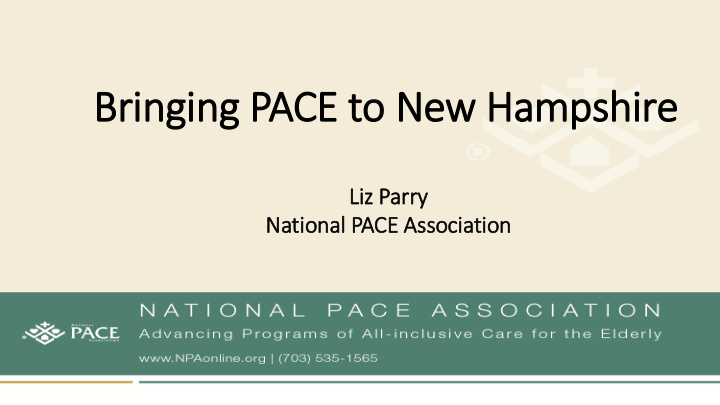



Bringi ging P g PACE t CE to New Ha Hampshire Liz P Parr rry Nati tional P PACE Associati tion
Outline I. Introduction II. PACE 101 III. State Requirements and Issues IV. Federal Requirements and Issues V. Q&A
PACE 101 101
What i t is PACE? E? Seeing PACE Firsthand
What i t is PACE? E? • Comprehensive • Community Based • Coordinated • Capitated
PACE b E by the Number ers - What 124 PACE 242 PACE Centers Organizations 11 Average # Years Programs in Operation 6
PACE b E by the Number ers - Where re 31 19 Operate in Rural Areas PACE States 49% of all PACE organizations operate in 5 States 7
Wher ere e is PACE?
Who ho Do Does s PACE S E Serve? • 55 and older • At a Nursing Home Level of Care • Able to live in Community, with PACE services
PACE b E by the Number ers - Who 95% In Home & 42,000+ Participants Communities 76 A verage Participant Age 10
How D Does es P PACE Op Oper erate? e? PACE Center • Primary Care • Rehabilitative Care • Activities • Meals • In the Home • Transportation • Contracted Network: • Specialists • Hospitals • Assisted Living • Other •
Integ egrated ed Ser ervice De Delivery and T nd Team M Managed C d Care
Ou Outcom omes es • Better care • Fewer unmet needs • Improved chronic care management • Better functional support • Longer life • Higher Quality of Life
PACE C E Costs ts Reduces high cost of uncoordinated care • Fewer hospitalizations • Less ER use • Capitated = Predictable • PACE rate less than current Medicaid cost • No copays •
Who o Pays f for PACE CE C Care • PACE is a financially capitated program • Organizations receive a per member, per month payment to deliver all the necessary care • Breakdown of Participants • 90% dually eligible for Medicaid and Medicare • 9% Medicaid-only • 1% private pay, Medicare-only, other
Why P y PACE CE i in N New Ha Hampshire? Coordinated care • Keeps elders in their homes and their communities • Supports family caregivers • Reduces costly acute care • Takes full responsibility for meeting care needs, • at a predictable monthly cost Supports economic development and provides good jobs • Proven model •
State Requirements a and I Issues
State Pl Plan Am Amendment • State must amend its Medicaid Plan to elect PACE as a voluntary state option • The State Plan Amendment (SPA) and provider application processes can occur simultaneously • State must receive CMS approval of SPA before 3-way Program Agreement can be signed
State Pl Plan Am Amendment, c con ont. • The SPA covers three major components: 1. Clinical and financial eligibility and post-eligibility treatment of income requirements for PACE enrollees; 2. Medicaid capitated rates and payments (including rate setting methodology); and 3. Procedures for processing Medicaid enrollments and disenrollments in the state’s management information system
State R e Role e in PACE D E Devel elop opment • Site selection • Licensing and certification requirements • UPL(s) and Medicaid capitation rate(s)-setting • Program eligibility requirements and determination processes • Medicaid enrollment and disenrollment systems • Medicaid state plan amendment • Reviews/submits PACE provider application and participate in provider application process • Participates in 3-way Program Agreement • Medicaid contract, if necessary • Ongoing oversight and monitoring
Federal Requirements a and I Issues
CMS’s R Role e in PACE D E Devel elopmen ent • Responsible for development/implementation of federal PACE regulatory requirements • Implements Medicare payment methodology • Reviews/approves PACE provider applications and SPAs • Medicare enrollment and disenrollment systems • Participates in 3-way program agreement • Ongoing oversight and monitoring
Medicar are e Par art D D • PACE organizations offer Medicare Part D prescription drug coverage • Individuals who join a PACE program, will get your Part D-covered drugs and all other necessary medication from the PACE program • Prescription drugs provided under Medicare Part D will be covered in the Medicare capitation rates paid to PACE organizations and payment for non-Medicare covered outpatient prescription drugs and prescribed over the counter medications covered in the Medicaid capitation rate
Qu Ques estion ons? lizp@npao aonline.org
Recommend
More recommend